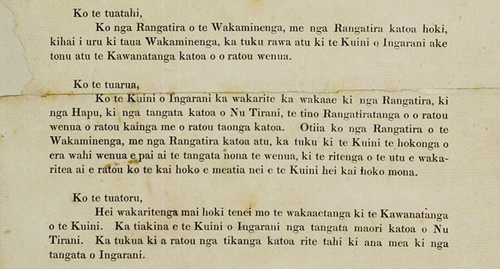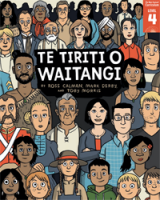Treaty of Waitangi principle
"The curriculum acknowledges the principles of the Treaty of Waitangi, and the bicultural foundations of Aotearoa New Zealand. All students have the opportunity to acquire knowledge of te reo Māori me ōna tikanga."
The Treaty of Waitangi principle is one of eight principles in The New Zealand Curriculum that provide a foundation for schools' decision making. The Treaty of Waitangi principle calls for schools and teachers to deliver a curriculum that:
- acknowledges the Treaty of Waitangi principles
- acknowledges our nation’s bicultural foundations
- enables students to acquire knowledge of te reo Māori and tikanga Māori.
Watch …
Looking at the Treaty of Waitangi curriculum principle
Wharehoka Wano shares his ideas about the importance and meaning of the Treaty of Waitangi principle. Whare offers simple strategies for schools and describes what might be seen in classrooms where the Treaty of Waitangi principle is enacted.
The Treaty of Waitangi as a curriculum principle
Janelle Riki talks about the Treaty of Waitangi, and suggests schools start by looking at the principles of the Treaty: participation, protection and partnership, and explore them through the lenses of whānau, students, and local iwi and hapu.
Read …
Ka Hikitia (the Māori Education Strategy, 2020)
Ka Hikitia sets out how the education sector will achieve system shifts and support Māori learners and their whānau, hapū, and iwi to achieve excellent and equitable outcomes. Ka Hikitia provides an organising framework for the actions that schools and supporting agencies will take.
Tau Mai Te Reo (the Māori Language in Education Strategy, 2020)
Tau Mai Te Reo is a companion strategy to Ka Hikitia. It sets out goals for the education sector and provides a framework for coordinating programmes and services that support Māori language in education.
NZC Update 16 – The Treaty of Waitangi principle
This update is structured around the three Treaty of Waitangi principles – partnership, protection, and participation. It provides information, resources, case studies, and questions to help you enact the Treaty of Waitangi principle at your school.
Te Tiriti o Waitangi: School Journal Story Library
This comic from the Instructional Series provides a fresh approach to the story of Te Tiriti o Waitangi, New Zealand’s founding document.
Mythbuster
The Treaty of Waitangi principle isn’t just about studying Treaty history or having a kapa haka group. The Treaty of Waitangi principle calls for schools to understand and honour Treaty principles in all actions and decision making. It is about making our country’s bicultural foundations evident in school policies, organisation, physical spaces, whānau and community engagement, and classroom planning and assessment.
Tools
MASAM spotlight
Use this spotlight to engage in professional learning about Māori achieving success as Māori. Explore what MASAM means to you and work together with your staff to devise ways to be more culturally responsive.
How do you give mana to Te Tiriti o Waitangi?
This resource encourages schools to consider how they are honouring the Treaty of Waitangi. You can read the descriptors of practice to reflect on how well you are meeting your obligations as a Treaty partner and to decide where to next.
What can I see, hear and feel in your learning community? (online PDF 5.9MB)
This resource describes what you might see, hear, and feel in schools that are honouring their obligations as Treaty partners. You can read the suggestions to see what you are already doing and what your future mahi could be.
School stories
Making time for te reo
Wellington College has tweaked its timetable to allow all Year 9 students to learn te reo Māori.
Iwi-based kaupapa supports learning
A Ngāti Toa learning hub, Te Puna Mātauranga, is supporting Māori education achievement through a unique model of collaboration between schools, whānau and Iwi.
Clendon Park School – Māori achieving success as Māori
This school snapshot explains what Māori achieving success as Māori looks like at Clendon Park School.
Papakowhai School – Using the MASAM framework
Papakowhai School uses the MASAM self review framework to help ensure they are delivering a culturally responsive local curriculum.
North East Valley School – A new environment, a new outlook
Principal John McKenzie explains the benefits of holding a curriculum development day at Puketeraki Marae, and describes how staff were supported to incorporate a Māori world-view into their local curriculum.
Wairakei School – Working in partnership with Ngāti Tūwharetoa
Schools in the Taupō area, including Wairakei School, have worked in partnership with Ngāti Tūwharetoa to ensure students learn about their iwi, its history, places, and stories.
Te Akau ki Papamoa School – Cultural inclusiveness
Principal Bruce Jepson shares his kura’s vision and journey in becoming one of New Zealand's leading mainstream schools in normalising the delivery of te reo Māori and cultural competencies and the positive impacts on student achievement, school, and community culture.
Leading whole-school te reo Māori development
The staff and board of Hukanui School decided that they would like to focus on te reo Māori development within their school. Principal David Mossop explains that it is very important as a leader to provide clear direction and to identify with the staff.
Growing te reo Māori capabilities
Tracey Hopkins outlines te reo Māori professional development programme in place at Hukanui School. Tracey explains how teachers are supported in their own personal learning, and also in their teaching of te reo Māori to their students.
Te reo Māori and language acquisition
Nadine Malcom from Hukanui School describes how teachers are mentored in their own learning of te reo Māori as well as supported with professional development in language acquisition teaching skills. In this way teachers learn how to effectively teach the language to others.
A culturally connected curriculum
At Te Kura o Hiruharama inquiry learning is aligned to the school vision statement. This digital story discusses how 'Hiruharamatanga' is actively incorporated into the school curriculum to ensure the localised curriculum is culturally connected.
Developing whānau priorities at Te Kura o Hiruharama
The staff and board at Te Kura o Hiruharama engaged with the community to identify priorities for student achievement. This digital story explains the process and the outcomes of this exploration and how this has transferred into the life of the school.
Engaging whānau through Māori graduation
Growing an educationally powerful partnership with whānau has been a key priority across the Mt Roskill campus. This film explains how the development of Māori graduation ceremonies has led to deeper community connections and growing pride in student achievement.
Te Kotahitanga at Kelston Girls' College
Carol Jarrett, HOD, Kelston Girls' College, discusses Te Kotahitanga principles and their application in leading change and classroom practice.
Resources
EDtalk – Seeing your school through the eyes of Māori parents
Janelle Riki-Waaka, CORE Education, talks about how schools can better reflect the bicultural heritage of Aotearoa New Zealand so that all students can connect to and see themselves in their school.
EDtalk – Te reo Māori in English medium schools
Tamara Bell challenges teachers in English medium schools to increase achievement for Māori students by teaching te reo Māori. She also emphasises the importance of valuing students' cultural identities, and establishing close connections with students and their whānau.
EDtalk – Recognising Māori potential
Janelle Riki-Waaka, CORE Education, addresses the question of what Māori achieving success as Māori looks like in schools and about redefining the idea of what success is, thinking of it from an indigenous point of view.
EDtalk – Nourishing te reo Māori in our schools
Janelle Riki-Waaka, CORE Education, talks about te reo Māori as a beautiful taonga for all kiwis. Janelle believes that all students, especially Māori, should be able to learn te reo in schools and it is the obligation of educators to have some proficiency in Māori and be nourishing this official language of Aotearoa to keep it alive for the future.
Treaty of Waitangi on NZ History
This website provides a comprehensive guide to the Treaty of Waitangi and Waitangi Day.
Te Takanga o te Wā – Māori History Guidelines Years 1–8
This resource provides a framework to support teachers to teach Māori history with their students. The content and context that you choose for your class could focus on building quality and collaborative engagement with your local iwi and hapū.
Te Reo Māori in English-medium schools
Information and resources relevant to the teaching and learning of te reo Māori in English-medium schools.
He Reo Tupu, He Reo Ora
This is an online multimedia resource for teaching and learning te reo Māori. The primary audience is students in years 1–6 learning at levels 1–2 of Te Aro Arataki Marau (the curriculum guidelines for te reo Māori). It contains eight units of work with reomations (animations in te reo Māori), videos on how the resource can be used, and marae protocol.
Ka Mau te Wehi!
This resource for year 7 and 8 teachers and students supports Māori language in schools. Ka Mau te Wehi! is an expression meaning awesome! or fantastic! It is used in this context to acknowledge and celebrate all achievements, large or small, that are made by the teacher and learner as they learn te reo Māori together.
Te Taura Whiri i te Reo Māori
An online resource to promote the use of Māori as a living language and as an ordinary means of communication.
Pepeha
This website is designed to help all New Zealanders introduce themselves in Te Reo Māori, through Pepeha.
Published on: 10 Mar 2020
Return to top






